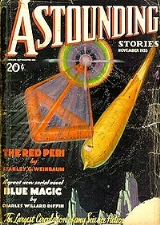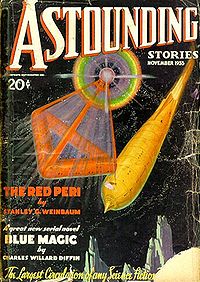
The Red Peri
Encyclopedia

Science fiction
Science fiction is a genre of fiction dealing with imaginary but more or less plausible content such as future settings, futuristic science and technology, space travel, aliens, and paranormal abilities...
novella
Novella
A novella is a written, fictional, prose narrative usually longer than a novelette but shorter than a novel. The Science Fiction and Fantasy Writers of America Nebula Awards for science fiction define the novella as having a word count between 17,500 and 40,000...
by Stanley G. Weinbaum
Stanley G. Weinbaum
Stanley Grauman Weinbaum was an American science fiction author. His career in science fiction was short but influential...
that first appeared in the November 1935 issue of Astounding Stories. Sam Moskowitz
Sam Moskowitz
Sam Moskowitz was an early fan and organizer of interest in science fiction and, later, a writer, critic, and historian of the field.-Biography:...
has noted that Weinbaum planned to write a series of sequels to "The Red Peri" but died before he could do so.. "The Red Peri" is the only Weinbaum story set on Pluto
Pluto
Pluto, formal designation 134340 Pluto, is the second-most-massive known dwarf planet in the Solar System and the tenth-most-massive body observed directly orbiting the Sun...
. The novel also inspired Arthur C. Clarke
Arthur C. Clarke
Sir Arthur Charles Clarke, CBE, FRAS was a British science fiction author, inventor, and futurist, famous for his short stories and novels, among them 2001: A Space Odyssey, and as a host and commentator in the British television series Mysterious World. For many years, Robert A. Heinlein,...
, who stated that David Bowman's helmetless spacewalk in 2001: A Space Odyssey was inspired by Frank Keene's escape from the pirate base in "The Red Peri".
Weinbaum's Pluto
"The Red Peri" was written only five years after the discovery of Pluto by Clyde TombaughClyde Tombaugh
Clyde William Tombaugh was an American astronomer. Although he is best known for discovering the dwarf planet Pluto in 1930, the first object to be discovered in what would later be identified as the Kuiper Belt, Tombaugh also discovered many asteroids; he also called for serious scientific...
, when the only things known about it were its orbit and the fact that its apparent magnitude
Apparent magnitude
The apparent magnitude of a celestial body is a measure of its brightness as seen by an observer on Earth, adjusted to the value it would have in the absence of the atmosphere...
was 14.90, too dim to be a gas giant
Gas giant
A gas giant is a large planet that is not primarily composed of rock or other solid matter. There are four gas giants in the Solar System: Jupiter, Saturn, Uranus, and Neptune...
. Given its known distance from the sun, this meant that the higher Pluto's albedo
Albedo
Albedo , or reflection coefficient, is the diffuse reflectivity or reflecting power of a surface. It is defined as the ratio of reflected radiation from the surface to incident radiation upon it...
was assumed to be, the smaller it would have to be. Weinbaum assumed that Pluto's surface was as dark as coal, and that its diameter was greater than Earth's, with a correspondingly greater gravity. Weinbaum also assumed that Pluto was airless and had a twenty-hour period of rotation and a surface temperature of 10 kelvin
Kelvin
The kelvin is a unit of measurement for temperature. It is one of the seven base units in the International System of Units and is assigned the unit symbol K. The Kelvin scale is an absolute, thermodynamic temperature scale using as its null point absolute zero, the temperature at which all...
s. Despite its harsh conditions, Weinbaum's Pluto includes a number of life-forms, all of them crystalline creatures called crystal crawlers that consume various elements, including aluminum, iron, and carbon.
Plot summary
Around the year 2080, the Dutch spaceship Aardkin out of VenusVenus
Venus is the second planet from the Sun, orbiting it every 224.7 Earth days. The planet is named after Venus, the Roman goddess of love and beauty. After the Moon, it is the brightest natural object in the night sky, reaching an apparent magnitude of −4.6, bright enough to cast shadows...
is approaching Earth
Earth
Earth is the third planet from the Sun, and the densest and fifth-largest of the eight planets in the Solar System. It is also the largest of the Solar System's four terrestrial planets...
when she is boarded by a notorious pirate ship, the Red Peri. Passenger Frank Keene, an American radiation engineer and spaceship pilot, sees that one of the pirates has red hair before that pirate literally tweaks his nose and leaves.
A year later, Keene and astrophysicist
Astrophysics
Astrophysics is the branch of astronomy that deals with the physics of the universe, including the physical properties of celestial objects, as well as their interactions and behavior...
Solomon Nestor are on board the Limbo, conducting a survey of cosmic radiation in the outer reaches of the Solar System
Solar System
The Solar System consists of the Sun and the astronomical objects gravitationally bound in orbit around it, all of which formed from the collapse of a giant molecular cloud approximately 4.6 billion years ago. The vast majority of the system's mass is in the Sun...
for the Smithsonian Institution
Smithsonian Institution
The Smithsonian Institution is an educational and research institute and associated museum complex, administered and funded by the government of the United States and by funds from its endowment, contributions, and profits from its retail operations, concessions, licensing activities, and magazines...
. One of the Limbo's stern jets melts, leaving the ship crippled. They are forced to land on Pluto, in the hope of finding a deposit of some refractory
Refractory
A refractory material is one that retains its strength at high temperatures. ASTM C71 defines refractories as "non-metallic materials having those chemical and physical properties that make them applicable for structures, or as components of systems, that are exposed to environments above...
metal they can use to build a new jet. Shortly afterwards, they are captured and taken to a secret base which turns out to be the lair of the pirates.
They meet the Red Peri herself, a nineteen-year-old redhead whose late father built the Red Peri and established the base sixteen years earlier. The Red Peri says she can't let Keene and Nestor go, and she doesn't intend to let them remain, but she hesitates to kill them in cold blood. She leaves them under guard while she ponders their fate.
One of their guards is a twenty-year-old blonde named Elza, whose dislike for the Red Peri is obvious to Keene. He learns that Elza is in love with a fellow pirate named Marco Grandi who, to her dismay, is enamoured with the Red Peri. Keene enlists Elza's aid by promising to help her win Grandi's love.
The next morning, Keene wakes up to discover the door to his room is unlocked. Elza tells him that the Red Peri has allowed him the run of the base; since he has no access to a spacesuit or the key to his ship, he can't escape. Breakfast with the Red Peri is followed by a tour of the base, ending with a view of a cavern full of oxygen ice. There, Keene rescues his captor from a swarm of "crystal crawlers" that feed on carbon. When Keene's toe falls prey to one of them, the Red Peri quickly cuts off the infected area.
While treating Keene's injured toe, the Red Peri reveals that she is the daughter of Perry Maclane, an inventor who was cheated out of his patent by Interplanetary, Inc. Swearing revenge, Maclane built the Red Peri, crewed it with others who had also been wronged by the company, and began preying on its spaceships. When the elder Maclane died three years ago, his daughter Peri took his place. Her ultimate plan is to use the money she makes from piracy to start a rival spaceline and put Interplanetary out of business.
Keene returns to his room to find that Nestor has been plotting with Elza. Her father has been working on the Limbo, so she can get the key. When Nestor tells Keene his plan, Keene is divided. The next morning, after Elza slips him Limbo's key with his breakfast, Keene arrives at the base's entrance to find the Red Peri being loaded with supplies; clearly, Peri Maclane is planning to raid more ships. Keene confesses his love for her and tries to persuade her to give up piracy, to no avail. He decides then that he will go along with Nestor's plan.
Keene jumps out through the electrostatic field that serves the pirate base as an airlock, taking a surprised Maclane with him. Carrying her, Keene sprints a thousand feet in the frigid vacuum of Pluto to the Limbo, barely making it to the airlock. He launches the Limbo, then chains the unconscious Maclane to a chair. When she wakes up, he explains that stories of humans exploding in vacuum are a myth—human tissue is strong enough to withstand the body's internal pressure for several minutes.
The Red Peri comes alongside Limbo but is unable to attack with Maclane on board. Keene falls asleep, and wakes to find Maclane and the Red Peri gone. A note she left explains that she used an iron-eating crystal crawler to free herself from the chain. Keene realizes she braved the vacuum of space again by jumping from the Limbo's airlock to the Red Peri.
Keene is certain Maclane will set up another base somewhere else in the solar system. He decides to leave government service and get a job on an Interplanetary freighter. Eventually, their paths will cross again.
Critical reception
Everett F. BleilerEverett F. Bleiler
Everett Franklin Bleiler was an editor, bibliographer, and scholar of science fiction, detective fiction, and fantasy literature. In the late 1940s and early 1950s, he co-edited the first "year's best" series of science fiction anthologies, and his Checklist of Fantastic Literature has been called...
reported that "the background is imaginative, but the romance is on the level of the shopgirl pulps, and the writing leaves much to be desired."
Collections
"The Red Peri" appears in the following Stanley G. Weinbaum collections:- The Dawn of Flame (1936)
- The Red PeriThe Red Peri (collection)The Red Peri is a collection of science fiction short stories by author Stanley G. Weinbaum. It was first published in 1952 by Fantasy Press in an edition of 1,732 copies...
(1952) - A Martian Odyssey and Other Science Fiction Tales (1974)
- Interplanetary Odysseys (2006)
The Project Gutenberg versions of "The Dawn of Flame" and "A Martian Odyssey" do not contain "The Red Peri". The full text of the novella is available here: http://homepage.ntlworld.com/forgottenfutures/weinbaum/peri.htm

